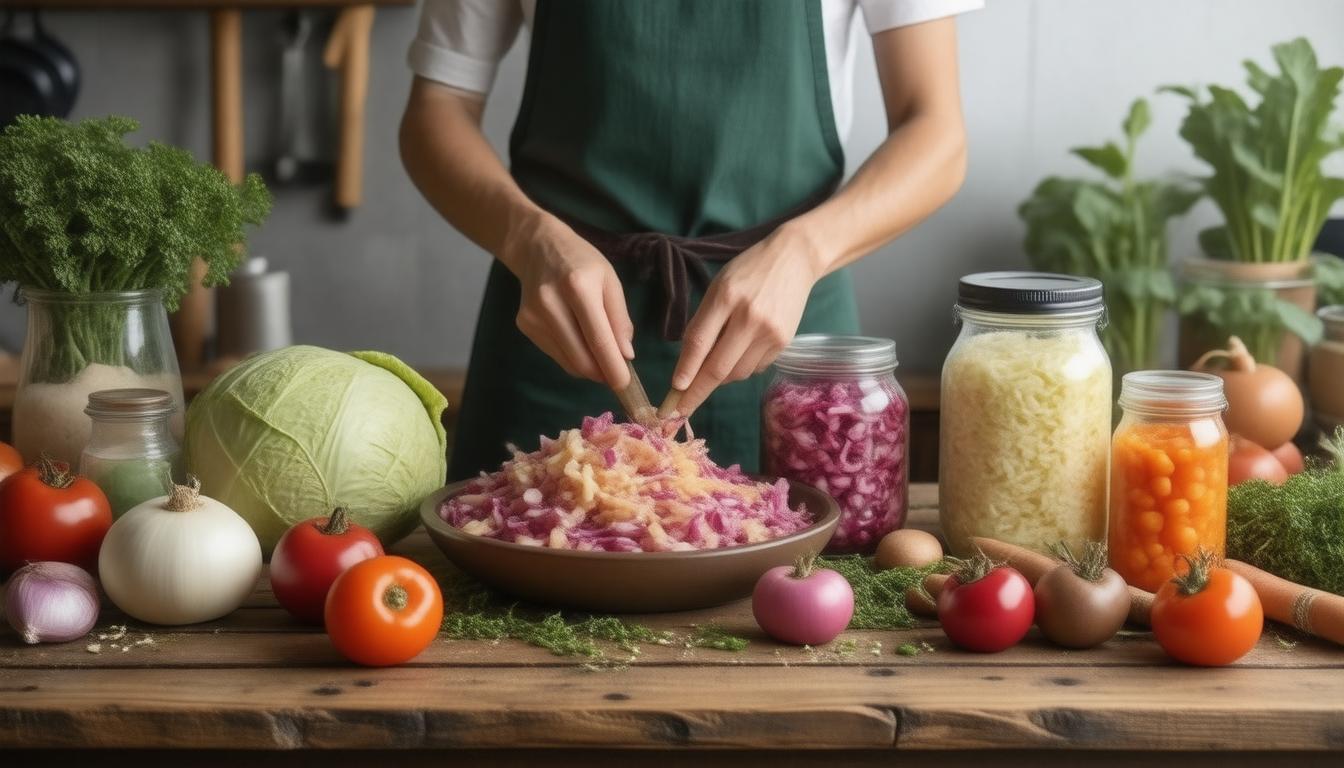Are you ready to boost your gut health and add a delicious crunch to your meals?
Unlock the power of probiotics with a simple homemade sauerkraut recipe that anyone can master!
Not only is sauerkraut a nutritious addition to your diet, but making it at home ensures you receive the full benefits of fermentation.
In this comprehensive guide, we’ll walk you through the easy steps to create your own tangy, probiotic-rich sauerkraut, while exploring its numerous health benefits.
Key Takeaways
- Homemade sauerkraut is a simple and cost-effective way to boost your probiotic intake.
- Fermentation enhances the nutritional value of cabbage, making it a healthful addition to your diet.
- Using the right ingredients and equipment is key to successfully fermenting sauerkraut for optimal gut health.
How to Make Homemade Sauerkraut: Step-by-Step Guide
## How to Make Homemade Sauerkraut: Step-by-Step Guide
Making homemade sauerkraut is not just a fun culinary project; it’s also a straightforward way to enhance your diet with probiotics.
Sauerkraut is a fermented food that relies on the natural bacteria found in cabbage, transforming an ordinary vegetable into a nutrient-dense powerhouse.
In this guide, we’ll walk you through the simple steps to create your own sauerkraut, highlighting the health benefits along the way.
### Why Homemade Sauerkraut?
Store-bought sauerkraut often undergoes pasteurization, a process that eliminates beneficial bacteria, rendering it less nutritious than its homemade counterpart.
By fermenting cabbage at home, you ensure the presence of live Lactobacillus bacteria, which are vital for gut health and overall wellness.
Plus, making it yourself is cost-effective and allows for customization in flavor.
### Ingredients Needed
To start making your homemade sauerkraut, you will only need three ingredients:
• Cabbage: 1 medium head (green or red)
• Salt: Coarse kosher or sea salt (approx.
2% by weight of the cabbage)
• Optional: Caraway seeds (for added flavor)
### Equipment Required
• Sharp knife or mandolin
• Large mixing bowl
• Mason jars or fermentation containers
• Fermentation lids and weights (optional but recommended)
### Step-by-Step Instructions
1.
Prepare the Cabbage:
– Remove the outer leaves of the cabbage and set them aside.
Cut the cabbage into quarters, remove the core, and shred it finely using a sharp knife or mandolin.
2.
Mix with Salt:
– In a large bowl, combine the shredded cabbage with salt.
Massage the cabbage with your hands for about 5-10 minutes until it begins to release its juices.
If you’re using caraway seeds, now is the time to add them.
3.
Pack the Jar:
– Transfer the cabbage mixture into your clean jar, packing it tightly to minimize air pockets.
Pour any released liquid over the cabbage to ensure it’s submerged.
If needed, use the reserved outer leaves to cover the shredded cabbage, preventing it from floating.
4.
Ferment:
– Seal the jar with a fermentation lid or cover with a cloth secured by a rubber band.
Place it in a cool, dark area at room temperature (around 65-75°F) for approximately 2-5 weeks.
– Check on the sauerkraut periodically and taste it starting at two weeks; the longer it ferments, the tangier it will become.
5.
Store:
– Once you’re satisfied with the flavor, transfer the sauerkraut to the refrigerator, which will slow the fermentation and preserve its flavor for several months.
### Health Benefits of Sauerkraut
Homemade sauerkraut is rich in probiotics, which are essential for gut health.
A healthy gut flora has been linked to enhanced immune function, better mood stability, and improved digestion.
Moreover, it’s low in calories yet high in important nutrients, including vitamins C, A, calcium, potassium, and fiber.
### Tips for Success
• Use Fresh Ingredients: Fresh, organic cabbage will yield the best results.
– Maintain Cleanliness: Sterilize your equipment to prevent unwanted bacteria from ruining your fermentation.
– Monitor Temperature: Keep the fermentation environment stable, ideally between 65-75°F for optimal results.
### Conclusion
Making homemade sauerkraut is a straightforward and rewarding process.
With just three main ingredients and minimal active prep time, you can create a nutritious, probiotic-rich food that adds flavor and health benefits to your meals.
Plus, once you master the basics, you can experiment with various flavors and ingredients.
Start your fermentation journey today for a delicious way to boost your gut health!
The Health Benefits of Sauerkraut and Probiotics
## The Health Benefits of Sauerkraut and Probiotics
Sauerkraut is not just a tasty addition to your meals; it’s a nutritional powerhouse brimming with health benefits.
The fermentation process used to create sauerkraut produces beneficial bacteria, specifically Lactobacillus, which are essential for gut health.
These probiotics assist in breaking down food, enhancing nutrient absorption, and supporting the immune system.
Studies suggest that a healthy gut microbiome is linked to improved mental health, reducing anxiety and depression symptoms, emphasizing the importance of incorporating fermented foods like sauerkraut into your diet.
Homemade sauerkraut retains its beneficial bacteria since it is unpasteurized, unlike many store-bought varieties.
It is low in calories yet abundant in vitamins C and A, calcium, potassium, and fiber, making it a nutrient-dense addition to any meal.
Regularly consuming sauerkraut can help maintain a healthy digestive system, boost your immune response, and provide your body with essential nutrients vital for overall health.
By making sauerkraut at home, you not only enjoy its delightful tangy flavor but also harness the full spectrum of its health benefits.
Incorporating this simple, affordable fermented food into your diet can lead to significant improvements in your gut health and overall well-being.




